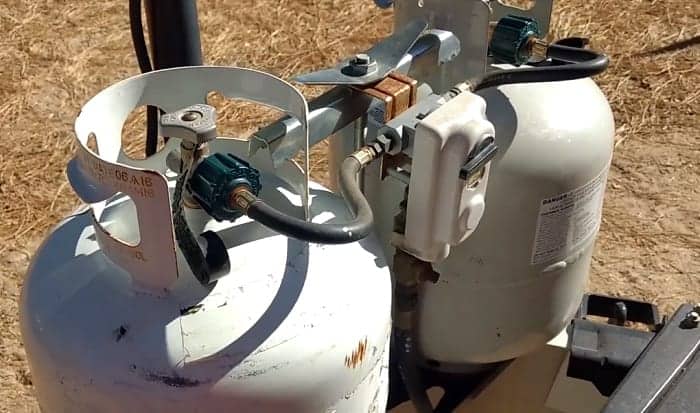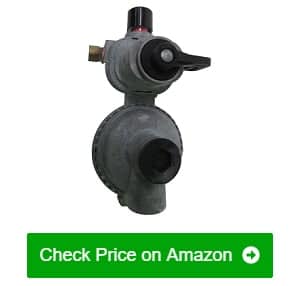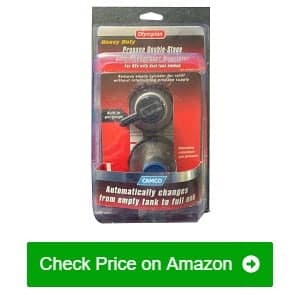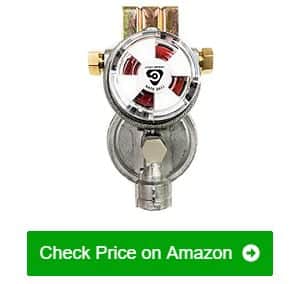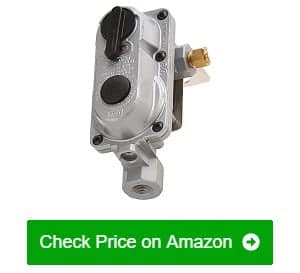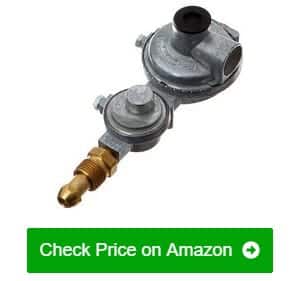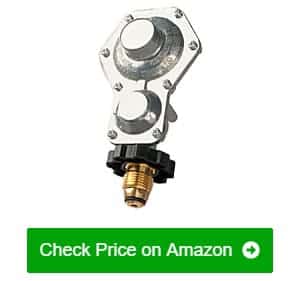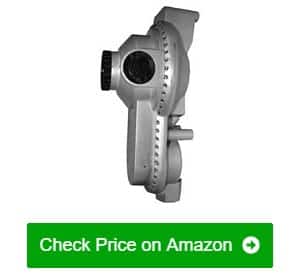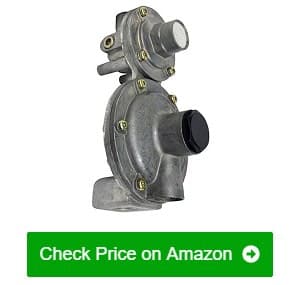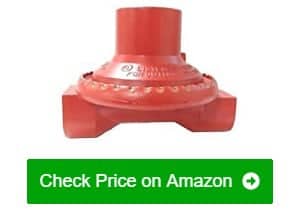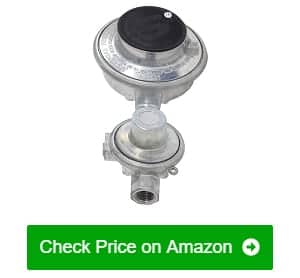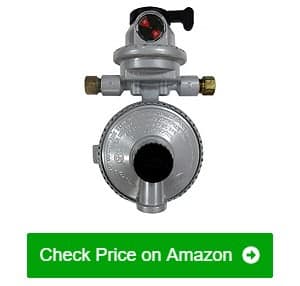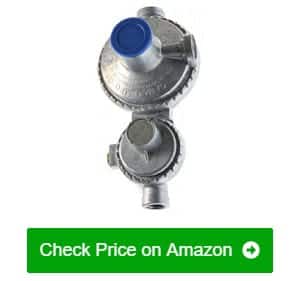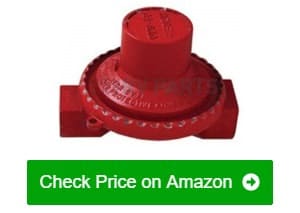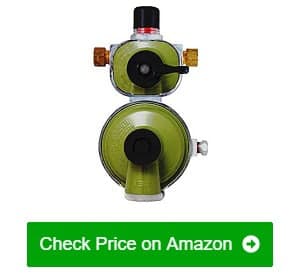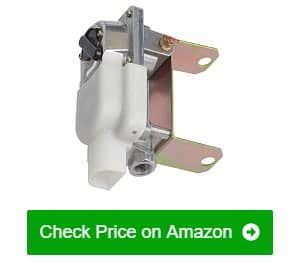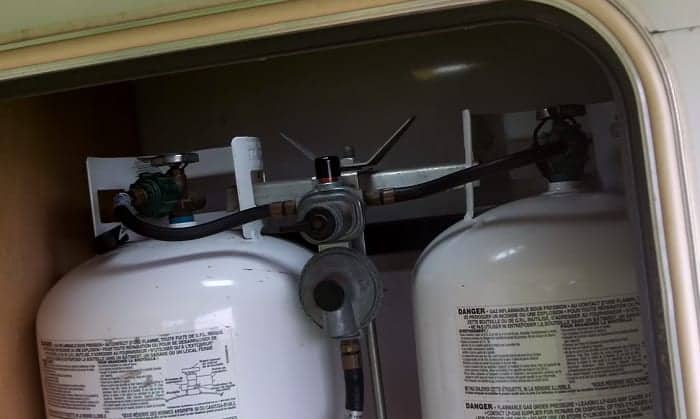There is no doubt that you need to use the best RV propane regulator if you want to keep all of your camping trips safe. A propane regulator, as the name suggests, controls the amount of propane coming out of the pressurized tank.
Without a regulator, the pressure of the propane coming out of the tank will be so strong that it would seem like you just lit a flame thrower instead of a grill. Using a cheaply made propane is almost as bad as not using one at all. It is worse.
If ever your propane regulator does break or malfunctions, then it will cause propane to leak into your RV. This issue can result in all sorts of potentially dangerous, mostly fatal situations.
If you are a beginner in the field of driving and riding RVs without knowing anything at all about propane systems, then this article is perfect for you. Here, you will learn all about propane regulators and why you need them. This article will also provide you with some product reviews and a guide on choosing the ideal one.
Table of Contents
Best RV Propane Regulator Reviews
1. Marshall Excelsior Megr-253 Regulator
The neat thing that I truly liked about this 2-stage propane regulator is that it allows you to use two propane tanks. This propane regulator has two inlet fittings that connect to the RV propane regulator hose directly connected to the propane tanks.
Although it looks like you will be using the two propane tanks at the same time, note that it is not what this propane auto changeover valve without regulator does. It is an auto-changeover propane regulator. You just twist the knob towards the direction of the high-capacity tank that you want to use as your primary.
Once the primary tank is spent, it will automatically change over to the secondary propane tank, which is still full. When the regulator switches over to the secondary tank, you will be able to remove the one tank from the regulator without any risk of spillage. It dramatically reduces the risk of fumes and explosions.
Another neat feature of this best propane regulator for RV is the fuel display. It is a way to signal the user that the tanks are already empty, and you need to replace them. If the indicator is still green, then keep in mind that there is still enough propane in the tank to send gas up through the tubes and out of the burners.
- Allows you to use two propane tanks for a long period
- Automatically switches to the secondary tank once the primary is spent
- Convenient and safe tank switching
- Lessens the chance of propane leaks
- Has a propane content indicator
- Very difficult to mount
2. Camco 59005 Propane Regulator
The thing that I liked the most about this 2-stage RV propane regulator is the dual-stage valve design. It helps maintain a constant pressure of propane going through the supply hose – that is, regardless of the tank pressure and the weather.
This two-stage propane regulator for RV also uses an automatic changeover. It means that if the primary tank runs out of propane, the regulator switches over to the reserve tank for continuous fuel supply. Once this happens, you can easily swap out the older tank with a new one without any risk of spills or leaks.
I like the extra safety provided by this regulator’s double stage design. It helps make sure that the gas pressure being fed to the burners, stoves, or grills is always a constant pressure. With that, expect the regulator to be very efficient when it comes to distributing the propane gas.
There is also a nifty indicator window that will tell if the primary tank is empty and in need of refilling. The direction where the crossover handle is pointing is the “primary” tank. It does not matter which one is bigger. When the indicator turns red, it automatically opens up the secondary tank valve.
- Allows the use of two propane tanks for a continuous supply
- Double stage design, thereby ensuring constant pressure throughout
- Automatically switches over to the reserve tank once the primary is empty
- Has a neat indicator window to tell if the primary tank is spent
- Helps prevent accidental spills or propane leaks
- Has a short service life
3. Cavagna 52-A-890-0006C Regulator
This product is one of the neater-looking regulator valves that I have seen as of yet. Unlike the other regulators, the indicator window for this regulator valve is big and easy to read. There is no need to crouch down and squint.
Another good thing about this regulator is that it comes with an easy to install mounting bracket. This feature makes it a whole lot easier to mount this regulator onto the RV without risking any damage to it. It only took me less than fifteen minutes to install this regulator onto my RV, and I can say that I am not one of those handy guys.
One feature of this RV gas regulator that I cannot find in most other regulators is that you can make RV propane regulator adjustment for the amount of pressure that can pass through it. I like to use a wok sometimes, and it is nice that I can increase the propane pressure so that I can have enough heat for cooking fast.
The automatic changeover feature works flawlessly. The one installed in my RV has yet to fail in providing me with a continuous supply of propane. When the changeover valve kicks into action, it prevents any leaks when I disconnect the empty tank and connect a new, full propane tank in its place.
- Has a clear and large fuel indicator
- Easy to mount and install
- Smooth working changeover feature
- Can adjust the amount of pressure of propane going through the regulator
- Allows the use of two tanks for uninterrupted propane supply
- Uses smaller hoses than older systems
4. Flame King KT12ACR6 Regulator
The thing that I liked the most about this RV LP gas regulator is that it already comes with two pigtail hoses. It is pretty convenient because this regulator uses smaller hoses than the older model regulators.
Another feature I liked is the double-stage design. Unlike other regulators where the pressure sometimes rises and falls due to the weather outside, it can maintain constant pressure until the tanks are emptied.
This 2-tank propane regulator allows you to enjoy a continuous supply of propane. When the primary tank runs out of propane, the changeover valve automatically switches to the secondary tank. It allows you to take out the spent tank and have it refilled, and in the meantime, your appliances that rely on propane will still work.
Apart from all those, I found out that this product is one of the easiest regulators to mount and install. Granted, you still have to open up your stove and other propane appliances to take out any propane left in the lines, but that is all the prep that you will need to do.
- Comes with two free pigtail hoses
- Allows a continuous supply of propane to the RV
- Can take out the spent propane tank without having to turn off the system
- Has an efficient changeover valve that switches to the secondary propane tank when the primary runs out
- Easy to install
- The pigtail hoses that came with the regulator are a bit short.
5. Marshall Excelsior Megr-295 Regulator
I find this regulator from Marshall a top-notch product. It is entirely made of solid, die-cast alloy. There is no need to worry about it cracking or splitting open if you accidentally drop it during installation. It is because this regulator is built tough. You can be sure that it will last for many years.
Another thing I find favorable about this unit is that it is easy to install. There is no need for any fancy tools or whatnot. I used this regulator on a twenty-year-old RV, and I did not need to replace any of the old fittings. Everything worked together fine.
It is a two-stage regulator, meaning it can maintain a constant low-pressure output regardless of how full the tank is. I find it great for appliances that do not need high-pressure propane, like kitchen stoves and ovens, grills, heaters, and many more.
For those who want the best and are sticklers when it comes to details, as in you need to check the exact pressure coming out of the regulator, you will be glad to know that this has testing ports, one on each stage. You will know exactly how much gas passes through the supply hose.
- Well-made and can last for many years
- Easy to install as the process does not require the use of any special tools
- Has testing ports on both stages
- Two-stage design for constant pressure
- Compatible with the majority of older RVs
- Horrible packaging
6. GASPRO Propane Regulator
The two-stage design of this regulator promises consistent, low-pressure flow of propane from the tank to your propane appliances. What does it mean? It means that you will no longer experience rising and weakening flames from your stove or grill.
It also improves the efficiency of said appliances, thus saving a lot of money in the long run. One of the reasons why I like this RV propane regulator is that it is easy to install and use. I did not even use any tool at all, except perhaps a work glove, so I can grip on the handwheel better.
In just fifteen minutes, I managed to get an RV propane regulator replacement from Gaspro for the old, leaky regulator of my RV. Because it has a two-stage design, this regulator can handle tanks as small as five pounds to as large as forty pounds. It does not matter what size propane tanks you use. This product has got your back.
I also like that this regulator is highly weatherproof, seeing as this is made of very durable rustproof alloy materials. This weatherproof construction makes this product very suitable for outdoor cooking griddles and grills, as well as RVs.
However, although there are plenty of things to like about this propane regulator, it does have a couple of issues. The biggest problem I had with this product is the fact that after a couple of months’ worth of use, the handwheel cracked in half and fell off.
I still managed to remove the regulator from the tank using an adjustable wrench, but to have the handwheel fall apart on me was kind of disappointing.
- Provides consistent propane flow
- Makes propane appliances more fuel-efficient
- Can handle tanks from 5lbs to 40lbs, maybe even bigger
- The main body is made of durable alloy.
- Completely weatherproof
- The handwheel handle is quite fragile.
7. JR Products 07-30385 Regulator
Being a two-stage regulator, the JR Products 07-30385 promises to provide a consistent flow of propane from the tank to the appliances that use it. It is much safer compared to tank regulator regulators that are prone to pressure fluctuations, which is a safety hazard.
Another neat thing about using two-stage regulators like this one is that it makes the whole system a lot more efficient. I have noticed a considerable change in the length of time that a tank of propane lasts now that I am using a two-stage regulator. It kind of lasts much longer now.
It has a simple design, making it easy to install and replace. You do not need any fancy tools or anything, just your hands and a bit of dexterity. It only took me a couple of minutes to replace my old regulator with this one.
This product is made in compliance with the strictest industry standards. It is not a cheap regulator that will leak after just a couple of uses. You can be sure that this item will last for a couple of years and hundreds of hours’ worth of camping fun and convenience.
- The two-stage design promises consistent propane flow.
- Much safer compared to single-stage regulators
- Highly efficient in distributing propane
- Easy to install and replace when changing tanks
- Made according to strict government restrictions, guaranteed to last
- The handwheel is a bit brittle and tends to crack after a couple of months.
8. Mr. Heater F273763 Regulator
The neat thing about this Mr. Heater regulator is that it keeps the pressure of propane going through the supply hose constant. It makes sure that the flames from your RV’s stove do not jump or sink during use. It adds another welcome layer of safety.
Aside from keeping your RV’s propane system safe, it also increases the efficiency of all the appliances that use propane. Take the stove as an example. Because the propane pressure remains constant, it means very minimal propane is wasted.
I also like that the second stage can be loosened and re-oriented to different positions. It is a useful feature, especially if it will be installed in a cramped or a custom position. It also uses tamper-resistant screws so no one else can make changes that quickly.
Unlike other cheap regulators, the edges are not crimped that are usually prone to RV propane regulator leaking. The seams are airtight and very secure.
- Maintains a constant pressure of propane going into appliances
- Makes the entire RV propane system more fuel-efficient, leading to plenty of savings
- The second stage can be re-oriented in a different direction when needed.
- The seams are not just crimped but are also more resistant against leaks.
- The unit is weatherproof that you can use it not only in RVs but also for outdoor grills.
- It does not come with a mounting bracket.
9. Appizz LP/Propane Regulator
This product is not a regulator that you can use in an RV because the output pressure is too high. However, it is more suitable for outdoor cooking appliances, especially in locations that are often windy.
This Fairview RV propane regulator is durable. It has a truly solid built. Just looking at it and holding it in your hands, you can quickly tell that this product is made to last. I bought this one for a wok burner, and I do not think I will need to buy another one for as long as I live.
This regulator is capable of producing up to 500,000 BTU/hr., which is a massive amount of propane. Although you might not be using that much propane all the time, it is nice to know that you can if you needed to.
The thing that I liked the most is that this regulator is very easy to install and use. You just need a regular wrench and maybe some Teflon tape just to make sure that there will not be any leaks whatsoever.
- Made of solid die-cast alloy for maximum strength and durability
- It can produce up to 500,000 BTU/hr.
- Suitable for outdoor use, even in inclement weather
- Solidly built; it can last for many years
- Easy to install and operate
- No way of reducing the amount of pressure
10. Sturgi-Safe RV Regulator
Although this unit is not precisely a high-pressure propane regulator, it is capable of producing up to 400,000 BTU/hr., which is almost the same rate. This two-stage regulator can be used outdoors, even during inclement weather.
Because this product has a two-stage design, it keeps a constant pressure output regardless of how much propane is left in the tank. It prevents the propane from pulsing, causing the flame on your stove to flicker and rise sometimes.
Due to the constant flow of propane, it means that the appliances that use it become a lot more efficient. There is very little waste. You can expect your propane tanks to last a bit longer than before when using this regulator. I noticed how much longer I can use a full propane tank now that I am using this product.
If you want to monitor the pressure coming out of the regulator, then there is a side tap where you can connect a pressure gauge. It is suitable for tracking the amount of propane still left in the tank as the pressure will significantly drop when it is half-empty.
- Well-built, one of the prettiest regulators I have used
- Works as advertised; it can provide a consistent pressure
- Makes the propane appliances in the RV more efficient
- Easy to install as you just need a regular wrench for the process
- Has side ports for pressure gauges
- Does not have mounting brackets
11. Fairview Propane Regulator
The thing that I liked the most about this regulator is that this is a two-stage unit. It also has an automatic changeover valve. You are essentially getting two kinds of a regulator in one.
I like this dual propane tank regulator because I can hook up two propane tanks to my RV at once. When the primary tank runs out of propane, the changeover valve will switch over to the secondary tank. At this point, I can disconnect the empty tank, have it refilled and reconnect it to the regulator.
I can do all those without having to turn off the gas in the RV. There is also a large indicator that tells you when the primary tank is empty. When the gauge turns red, it means the primary tank is empty, and the regulator has changed over to the secondary tank already.
Also, because it is a two-stage regulator, you can be sure that the propane flow will be smooth and uniform. Ever since I switched over to this regulator, I no longer experience any propane fluctuation anymore.
- Boasts of a two-in-one design; a two-stage and two-tank regulator in one
- Allows the use of two propane tanks
- Provides a virtually uninterruptible propane source
- The two-stage design provides steady and constant gas pressure.
- Allows the safe removal and replacement of empty tanks
- There are no mounting screws included and the mounting holes are not tapped
12. Camco 59333 Regulator
This unit is a two-stage propane regulator, which means that it can provide a smoother and more consistent flow of propane through the lines of the RV. Ever since I started using this regulator, the propane fluctuations have become so weak they are almost negligible.
It is effortless to install. There is a handwheel handle on the end that screws into the propane tank, of which the only tool that you will need to use is a thick work glove or nothing at all. The other end is where you screw in the line going into the RV. It just took me less than ten minutes to install and test for leaks.
This regulator is one of those options can fit into any standard pol fitting, which means if your RV uses older model propane tanks, then this is the right one for you. Thanks to the two-stage design, I almost emptied my propane tank, there was hardly any liquid propane left inside. It helped make my RV more propane-efficient.
I noticed a significant increase in the length of time I can use a cylinder of propane. The only problem that I had with this regulator is that the safety mechanism is triggered when I open the tank valve too fast.
I had to reset the safety mechanism by turning off the tank valve and then slowly unscrew the part that screws into the tank. You need to slowly open the tank valve to prevent triggering the safety again.
- The two-stage design promises a smooth and steady flow of propane.
- Makes the RV more fuel-efficient
- Easy to install, no specialized tools needed
- Can fit into older propane tank designs
- Ideal for older model RVs
- The safety mechanism is too sensitive.
13. JR Products 07-30325 Regulator
This product is the regulator that you need if you are looking for something that you can use for outdoor cooking, but the weather in your area is often inclement or windy most of the time. This high-pressure regulator can make sure that enough propane reaches the burner for a consistent flame.
As mentioned earlier, this regulator is primarily meant for outdoor cooking. It is capable of producing up to 500,000 BTU per hour, which is enough to produce a consistent flame that even a strong gust of wind will not be able to snuff out.
You can tell just by holding this heavy regulator that it is pretty solid and can probably last for many years of regular use. When I bought mine, I can tell that it will be the first and last high-pressure propane regulator that I will own, and after a couple of years, I still believe that.
However, the thing about this regulator that I truly loved is the fact that it is straightforward to install. There are no fancy tools needed and no prior preparation. When I installed mine on my outdoor gas burner, it only took me less than fifteen minutes, and I am not all that handy with tools.
- Made of solid alloy as it can last for many years
- Capable of 500,000 BTUs per hour
- Made for the outdoors, thanks to its weatherproof and rustproof nature
- Easy to install even without any advanced tools or knowledge
- Produces very uniform and constant propane pressure
- Cannot reduce the pressure using the regulator
14. Marsh Excel Megr-253H Regulator
This product is a dual propane tank regulator, which is an excellent upgrade to any RV, especially if you are like me, who is fond of taking long camping trips, like around a month or two. Having two propane tanks on the ready makes life easier.
Another thing that I truly liked about this 2 stage propane regulator is that it has an automatic changeover valve. It means that if the primary propane tank is spent, the valve will close on that side and open up the one at the side of the secondary tank. In other words, you will not be caught by surprise that you are out of propane.
Aside from being a dual tank regulator, it is also two-stage. It means that this regulator prevents propane pressure surges. I have been having problems with my older regulator wherein the gas pressure will suddenly rise when it gets a bit warm outside. I do not find it as a problem anymore with this regulator.
I am also glad that there is an indicator window right on the regulator that will tell if the primary tank is already empty. I find this very useful as it will signal that I am already using the secondary tank, which means I need to get the other tank refilled whenever I can.
The thing about this type of regulator is that you need to mount it, and the problem is that it does not come with a mounting bracket, not even screws. Furthermore, the mounting holes are not threaded.
I had to make my mounting bracket, which is not a big deal. However, I did have to buy a couple of different self-tapping screws as there are no indications of what size I need to use.
- Provides a continuous supply of propane, thanks to the dual tanks
- Prevents leaking and spills when replacing tanks
- Automatically switches to the full tank when the primary one gets empty
- Has a nifty indicator window
- Provides a smooth and uniform gas flow regardless of the contents of the tank or the climate
- Mounting this regulator can be quite a pain.
15. UFPD 2-Stage Propane Tank Regulator
This unit is one of the nicer-looking LP pressure regulators that I have ever seen. It has a plastic rain cover that provides extra protection. First of all, it is a two-stage pressure regulator. It means that it does an excellent job of minimizing or eliminating propane fluctuations.
If your RV stove sometimes has yellow flames instead of clean blue ones, then there is a problem with the regulator. I have not yet experienced that when I started using this one. Another thing I liked about this product is that it allows the user to connect two propane tanks.
It allows for an uninterrupted supply of propane, which is good for RVs and food trucks. Once the primary tank is spent, the valve will automatically switch to the other tank for supply. If the valve for the secondary tank is opened, one can safely remove the empty propane tank and have it refilled.
There is no risk of leaking or spilling as the valve connection has already been closed off. Of all the regulators that I have tested so far, it is probably the easiest to install. It already comes with a mounting bracket, which requires minimal drilling.
Also, this regulator comes with two pigtail hoses included in the package. There is nothing else that you need to purchase. I have a problem with this, though, and that is the fact that the diaphragm is too noisy.
- Easy to install and comes with a mounting bracket
- Allows the use of two propane tanks for a continuous supply
- Provides a constant gas pressure
- Automatically switches to the full tank when the primary is empty
- No risk of leaks and spills when removing the empty tank
- Can get a bit noisy
Best RV Propane Regulators Buying Guide
How Does an RV Propane Regulator Work?
The reason why you need to use a propane regulator is that you can control the amount of gas pressure coming out of the propane tank. On average, a propane tank is pressurized to around 100 psi, which is too high for use on propane appliances. Your stove will look like a flamethrower because of that large pressure.
Within the regulator is a rubber diaphragm with a pressure spring. It is what controls the amount of gas that passes through it. The way it works is that the force of the spring on the rubber diaphragm exerts a back pressure that retards the one coming from the tank. It then lowers the pressure exiting the regulator to a safe to use amount.
Speaking in general, using a stronger spring will result in a much lower gas exit pressure. The looser the spring, the higher the pressure exiting the regulator. Some regulators have a removable cap so that the user can replace the spring if it is too tight nor too loose for his preference.
It might be needed when higher pressure gas is required, like when cooking outdoors. However, most regulators have a fixed cap to prevent owners from tampering with the regulator and causing all sorts of accidents.
How Many Different Types of Propane Regulators are There?
First, there are high and low-pressure regulators. High-pressure regulators are usually painted red. These regulators vary in size, but most of the time, they have a quarter-inch side outlet for a pressure gauge.
You can often find them being used for cooking appliances that are often used outside during inclement weather, or when high-pressure propane is needed, like a wok burner. The low-pressure regulators can further be divided into single and 2 stage regulator propane.
However, since there are not that many single-stage regulators being sold today for safety reasons, it is more vital that you just learn about two-stage regulators. These regulators, as the name suggests, have two input stages and two separate pressure diaphragms.
The first stage will significantly lower the gas pressure coming from the tank, and the second stage will fine-tune the pressure, making sure that the gas pressure remains constant. The low-pressure regulators are the ones used most of the time in stoves, heaters, RV refrigerators, and a host of other appliances.
The reason why two-stage regulators are more popular is that they are much safer. Furthermore, they provide a more constant flow of propane to the appliances.
Who Makes the Best Propane Regulator for RV?
Many different companies out there manufacture propane products and accessories. However, some make the absolute best regulators, in my opinion. They are Cavagna, Flame King, GASPRO, Mr. Heater, Appizz, Sturgi-Safe, Fairview, Camco, JR Products, Marshall Excelsior, and UFPD.
I have tried many different brands of propane regulators, but these are the only ones that I found to be reliable.
Are RV Propane Regulators Adjustable?
Some propane regulators are adjustable. However, it is highly recommended that people not get adjustable regulators unless they know what they are doing. In that sense, people who know next to nothing about propane should also avoid getting a high-pressure regulator.
If you are not knowledgeable when it comes to high-pressure containers and highly flammable substances, then you should not even go near adjustable propane regulators.
How to Install an RV Propane Regulator?
The neat thing about propane regulators, the safe ones specifically, is that they are effortless to install. Even if you do not hire the services of a plumber, you can do it on your own. Also, most of the time, you do not even need to use any kind of tool whatsoever.
First of all, make sure that the propane tank is tightly closed off. You should also do the same with the appliances where you will be connecting the tank. It means that if you are attaching the tank to an RV, you need to make sure that the stove, heater, refrigerator, and anything else that runs on LP is turned off.
Additionally, you should shut off the main propane line leading to the RV. Just close everything that you know will contain propane later. With everything safely closed, grab the propane tank. Remove the plastic seal from the outlet then proceed to screw in the inlet of the regulator.
Most regulators already have a handwheel, so you do not need any special tools whatsoever to connect it properly. You just need to hand-tighten the fittings together, but not too much as you might damage their threading.
Once done, connect the hose coming from the RV into the outlet of the regulator. It is effortless, but you might need a small wrench to tighten up the connection even more. With everything still shut closed, gradually open the propane tank to let the gas flow through the regulator.
You need to do it gradually because the safety mechanism might kick in and prevent the passage of propane through the regulator. The diaphragm should make a faint, humming noise for a while. It is the sign that propane is flowing through the lines.
Now is the time for you to check for leaks. The easiest way to do this is to get an old, wet kitchen sponge, one that you will be replacing soon. Put a couple of drops of dishwashing soap on it. Work it until it bubbles. Wipe the wet kitchen sponge all over the regulator, over the fittings, and along with the hose.
If you see any bubbles forming on the different parts, then that means there is a leak. When the leak is coming from the fittings, turn off the tank. Unscrew the fittings, apply Teflon tape on the threading, and securely screw it back onto the tank.
If the leak appears along the hose, then you need to replace it immediately. If you are not in the position to do this right now, then patch it up as good as you can.
When Should I Replace My Propane Regulator?
What are the symptoms of a bad propane regulator? Ideally, the best time to replace your regulator is when it starts to develop leaks. It is the reason why you should regularly check for leaks like every month or so.
Another time to replace regulators is when you notice a considerable drop in propane pressure coming through the lines, especially if your propane tank is full. There might be something blocking the regulator, or the diaphragm might be binding up.
You should never try to repair a regulator yourself. Just get a new one as these are not expensive at all.
How to Troubleshoot RV Propane Regulator?
If your RV’s propane appliances are not working as they usually do, there are a couple of RV propane regulator troubleshooting tips that you can safely do yourself.
Check the regulator for obstructions – Food and oil from the stoves could have found their way into the burners and eventually into the regulator. You can clear this up by just cleaning your burners and/or disconnecting the regulator.
Let the nasty gunk that got in there drip out. You can also use canned air to blow out the debris from inside the regulator.
Check the hose for leaks – If you smell propane inside your RV or if the propane alarm goes off, turn off the tank and air out your entire RV. The reason why there is propane inside the vehicle could either be a loose connection or a busted propane hose. To check, get a spray bottle and fill it with soapy water.
Spray the soapy solution over the propane lines and onto the regulator then turn on the tank. If bubbles are forming around the regulator fittings, turn off the propane tank. Remove the regulator and attach it again. This time, make it tighter.
If the bubbles are forming along the hose, then that means there might be a puncture or a rip in the hose. You will need to replace the entire hose.
Check for strange noises – Most of the time, the noises that you will hear come from the regulator, but that is not always the case. If you hear a humming or a gurgling sound coming from the regulator, then that is a sign that the propane tank is too full. The gurgling comes from the liquid propane pooled inside the regulator.
Never try to drain the excess propane from your tank. Doing so can be quite dangerous. Turn off the propane valve and take it to your propane dealer. They are the ones that have the right tools for the job. If your propane tank is directly mounted on your RV, then contact your propane supplier for help.
How Do You Know if your Propane Regulator is Bad?
Here are some of the most common RV propane regulator problems that you would encounter when you have a bad propane regulator:
- Yellow or orange flames instead of blue
- You hear a weird popping noise when you turn on the burner.
- The flames are floating above the burner holes, not coming from them.
- You hear a roaring noise from the burner.
- There are flames in the air intake.
- Flames spilling from underneath the burner plate
- A lot of soot and dirt on the burners themselves
- If you see any of these signs, immediately replace the propane regulator before anything serious happens.
How Do You Keep a Propane Regulator from Freezing?
One way to prevent this from happening is to buy your propane from a retailer who adds methyl alcohol inside the tanks. Methyl alcohol acts as an antifreeze that prevents the regulator and tank valve from icing over. If this is not possible, you can just slowly pour some hot water onto the regulator and on the tank valve.
Care and Maintenance
There are many ways that you can preserve the longevity of your propane regulator. First of all, make sure that no food spills from your pots and pans and into the burners. You can do this by using proper-sized pots and pans and not overfill them. Alternatively, you can get a drip shield that catches the spills.
Furthermore, you should also turn off the propane tank if you are not going to use the burner or if you will not be going on a trip in your RV anytime soon. Doing such will relieve a lot of pressure from the regulator diaphragm, making it last longer.
Buying Guide
If there was ever anything that you should not cheap out on in your RV, it is the propane tank regulator. Aside from having the risk of dealing with problems with your propane supply, there is also the real danger of propane leaks and fires in case you decide to invest in cheap and low-quality propane regulators.
It is the main reason why you need to get the best regulator that you can find and afford. To help you shop around for a new regulator, here are some of the things that you need to consider carefully.
Capacity – Will you be bringing one or two propane tanks? If you are bringing along just one, then the traditional single connector regulators will do fine. However, if you will be going on a rather long trip, then you will need to bring along two propane tanks. In such a case, you may want to use a regulator with pigtail hoses.
These regulators allow you to connect two propane tanks into your RV’s propane system. When one tank runs out of fuel, the regulator automatically switches over to the other tank. With that, there is an assurance that you will always have an uninterrupted supply of propane. It also lets you replace the empty tank safely without having to turn off the entire system.
Ease of installation – You will most likely be the one to install the propane regulator, so it has to be pretty straightforward and easy to install. Ideally, the regulator should not require the use of any special tools. It should not even need a wrench.
Propane regulators should be very easy to install by hand. When you are shopping for a regulator, ask the salesperson who is assisting you on how to install the item. If you can easily follow the instruction just by the person’s instructions, then you can be sure that you can do it yourself when you get home.
Must be weatherproof – If you will be using the propane regulator in your RV, then it is most likely located outside. There are many reasons why the tanks and regulators are outside the RV. The first probable reason is that if the tank leaks, the cabin will not fill with the toxic and highly flammable fumes.
When you get a propane regulator, check if it has its built-in cover. This cover should be able to protect it against rain, snow, intense heat, and other kinds of punishment that Mother Nature can throw at it.
BTU rating and capacity – One of the most critical factors you have to consider when you are shopping for a propane regulator is its particular BTU rating and capacity. A regulator that can handle a higher capacity will be able to supply more gas to the burners than one with a lower capacity.
Consider the number of appliances in your RV that use propane. If there are lots that use the propane at the same time, then you need a regulator that can provide all of them with the propane that they will need to operate correctly.
Other Propane Regulators We Reviewed
GASPRO 5FT Two Stage Propane Regulator
By investing in this regulator, you will be able to use one that combines both ease of use and superb safety features.
Key Features:
- Two-stage regulator eliminates sudden pressure drops and rises
- Made of 100% solid brass for utmost durability
- Auto shut-off when gas pressure exceeds a certain point
Fairview GR-9984 Regulator
This regulator is for the serious RVer. If you like taking RV trips that usually last a couple of months at the very least, then it is the type of regulator you need.
Key Features:
- 345,000 BTU/hour capacity
- Can connect two propane tanks at the same time
- Has an automatic changeover valve that switches to the secondary tank when the primary is empty
Mr. Heater F273766 Auto-Changeover Two-stage Regulator
The many great features of this two-stage regulator are among the reasons behind its popularity among several RV owners.
Key Features:
- Has a watertight cover to protect the regulator from the weather
- Comes with an auto changeover valve
- The two-stage regulator provides an extra layer of security.
Cavagna Kosan 924N RV Auto Changeover Regulator
Never forget to replace the empty tanks again with this regulator’s large changeover dial.
Key Features:
- 220,000 BTU/hour capacity
- High-quality, heat-resistant diaphragm
- Large, clear changeover dial
Mr. Heater F273863 Horizontal Vent Propane Regulator
This item is a no-nonsense, no-frills propane regulator. It is designed to provide a safe and reliable propane supply.
Key Features:
- Horizontal vent on the first stage
- Excess flow protection
- Two-stage regulator for steady propane flow
JEASOM Two Stage Propane Regulator
This regulator has a wide range of uses other than the RV, making it a good investment overall.
Key Features:
- Made of solid brass, ensuring durability and secure connections
- Two-stage regulator for steady propane flow
- Easy to install as the whole process does not require any tools
Marshall Excelsior MEGR-130-30 High-Pressure Regulator
This unit is not your ordinary propane regulator. This one is for high-pressure needs, like wok burners.
Key Features:
- Can handle up to 250 psi
- May be used as a pre-regulator for additional safety
- Highly leak-resistant
Cavagna 52-A-490-0003C Two-Stage Regulator
This two-stage regulator provides a bit more protection than the usual, which is something that you might want to consider.
Key Features:
- Combination regulator with the first stage having the ability to regulate to 10 psi and the second maintaining the 11-inch water table working pressure
- Has excess flow cutoff feature
- Used in RVs with single vertical/horizontal tank
Marshall Excelsior (MEGR-298) Excela-Flo Regulator
This product is a compact regulator that provides the same reliability as regular-sized ones.
Key Features:
- Raw zinc outer coating that prevents rust
- Adjustment bolts on both stages
- Can handle up to 250 psi inlet pressure
GasOne 2130 Dual Two-Stage Propane Regulator
This item is a non-adjustable regulator, meaning there is less chance of anything leaking. You have a guarantee that everything is sealed tight.
Key Features:
- The two-stage regulator prevents sudden bursts of high pressure.
- Can be used in other propane appliances other than RVs
- Very easy to install, can be tightened and loosened by hand
Conclusion
Never directly connect a propane tank to your gas burner unless you are thinking of burning down your RV. A propane regulator will make sure that your appliances will receive a constant and safe amount of propane for them to work correctly.
Now that you know what to look for in the best RV propane regulator, you can now go out there with confidence, knowing that you will be getting something that will make your camping trips that much safer.

Hi, I am Tom Hank, an RV-er since 2014. Back then, I started without much help. As you can imagine, the struggles are endless. But now, you do not have to begin your adventures knowing next to nothing about RV lives.


